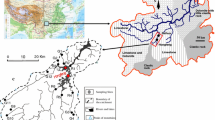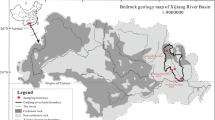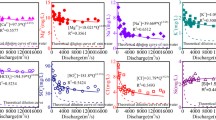Abstract
New findings have shown that the contribution of carbonate weathering to the atmospheric CO2 sink is far greater than previous estimates, through the combined action of carbonate dissolution, the global water cycle, and photosynthetic uptake of dissolved inorganic carbon (DIC). However, in order for calculations to be accurate, any carbon source effect should be deducted from the overall carbon sink. In this study, we carried out high temporal resolution monitoring of flow and hydrochemistry within the Xiaolongbei (XLB) silicate catchment and Beidiping (BDP) carbonate catchment for 1 year. We found the dissolved inorganic carbon concentrations to be higher in BDP than in XLB, and the annual inorganic carbon fluxes in BDP are roughly 23.8 times higher than those in XLB. Similarly, the rate of carbonate rock dissolution is much higher than the rate of silicate rock dissolution. We find carbonate rock dissolution to respond rapidly to rainfall events, and it is sensitive to rainfall changes on hourly, diurnal, and seasonal scales. The high rate of carbonate rock dissolution gives rise to the high concentrations of DIC, Ca, Mg, and to the high inorganic carbon flux in this basin. Differences between the theoretical and calculated contributions of atmospheric and soil CO2 to the DIC are possibly due to CO2 outgassing.





Similar content being viewed by others
References
Anthony DM (1998) Seasonal effects on the geochemical evolution of the Logsdon River, Mammoth Cave. Western Kentucky University, Kentucky
Berner RA (1991) A model for atmospheric CO2 over phanerozoic time. Am J Sci US 291:339–376
Berner EK, Berner RA (1987) Global water cycle: geochemistry and environment. Prentice-Hall, New Jersey
Cao J, Wang F (1998) Reform of carbonate rock subsurface by Crustose Lichens and its environmental significance. Acta Geol Sin Eng Ed 72:94–99
Cao J, Pan G, Yuan D, He SY, Lin YS (1999) Atmospheric CO2 Dynamics in the Guilin karst depression ecosystem and environmental significance. Geol Rev 45:105–111 (in Chinese with English abstract)
Cao J, Zhou L, Yang H, Lu Q, Kang Z (2011) Comparison of carbon trasfer between forest soils in karst and clasolite areas and karst carbon sink effect in Maocun village of Guilin. Quat Sci 31:431–437 (in Chinese with English abstract)
Chen J, Zhang DD, Wang S, Xiao T, Huang R (2004) Factors controlling tufa deposition in natural waters at waterfall sites. Sed Geol 166:353–366
Collins R, Jenkins A (1996) The impact of agricultural land use on stream chemistry in the Middle Hills of the Himalayas, Nepal. J Hydrol 185:71–86
Dai W, Wang Y, Huang Y, Liu J (2004) Flush of carbon dioxide caused by soil drying and rewetting. J Agro Environ Sci 23:318–322
Drever JI (1994) The effect of land plants on weathering rates of silicate minerals. Geochim Cosmochim Acta 58:2325–2332
Dreybrodt W (1988) Processes in karst systems, physics, chemistry, and geology. Chemistry and Geology, Springer, Springer-Verlag, Berlin, New York
Drysdale RN (2001) Factors controlling the hydrochemistry of Louie Creek, a travertine-depositing stream in the seasonally wet tropics of northern Australia. Mar Freshw Res 52:793–804
Finlay JC (2003) Controls of streamwater dissolved inorganic carbon dynamics in a forested watershed. Biogeochemistry 62:231–252
Franzluebbers A, Haney R, Honeycutt C, Schomberg H, Hons F (2000) Flush of carbon dioxide following rewetting of dried soil relates to active organic pools. Soil Sci Soc Am J 64:613–623
Groves C, Meiman J (2000) Regional atmospheric carbon sink within the south central Kentucky karst. In: Proceedings of the Eighth Mammoth Cave Science Conference, pp 131–141
Groves C, Meiman J (2001) Inorganic carbon flux and aquifer evolution in the South Central Kentucky Karst. In: US Geological Survey Karst Interest Group Proceedings: Water-Resources Investigations Report, pp 01–4011
Hartmann J, Jansen N, Dürr HH, Kempe S, Köhler P (2009) Global CO2-consumption by chemical weathering: what is the contribution of highly active weathering regions? Global Planet Change 69:185–194
Haynes R (1990) Active ion uptake and maintenance of cation-anion balance: a critical examination of their role in regulating rhizosphere pH. Plant Soil 126:247–264
Herman JS, Lorah MM (1988) Calcite precipitation rates in the field: measurement and prediction for a travertine-depositing stream. Geochim Cosmochim Acta 52:2347–2355
Hinsinger P, Plassard C, Tang C, Jaillard B (2003) Origins of root-mediated pH changes in the rhizosphere and their responses to environmental constraints: a review. Plant Soil 248:43–59
Hope D, Palmer SM, Billett MF, Dawson JJ (2004) Variations in dissolved CO2 and CH4 in a first-order stream and catchment: an investigation of soil–stream linkages. Hydrol Process 18:3255–3275
Huang F, Tang W, Wang JL, Cao JH, Yin JJ (2011) The influence of allogenic water on karst carbon sink: a case study in the Maocun subterranean river in Guilin, China. Carsologica Sinica 30:55–59 (in Chinese with English abstract)
Krawczyk WE, Ford DC (2006) Correlating specific conductivity with total hardness in limestone and dolomite karst waters. Earth Surf Proc Land 31:221–234
Kump LR, Brantley SL, Arthur MA (2000) Chemical weathering, atmospheric CO2, and climate. Annu Rev Earth Planet Sci 28:611–667
Lal R (2008) Carbon sequestration philosophical transactions of the royal society of London B. Biol Sci 363:815–830
Lerman A, Wu L (2006) CO2 and sulfuric acid controls of weathering and river water composition. J Geochem Explor 88:427–430
Lerman A, Wu L, Mackenzie FT (2007) CO2 and H2SO4 consumption in weathering and material transport to the ocean, and their role in the global carbon balance. Mar Chem 106:326–350
Li L (2012) Research on Karst/Geological Carbon Sinks Process and Flux in Chaotian Watershed, Guilin. Institute of Karst Geology, CAGS (in Chinese with English abstract), China
Li SL, Calmels D, Han G, Gaillardet J, Liu CQ (2008) Sulfuric acid as an agent of carbonate weathering constrained by δ13C DIC: examples from Southwest China. Earth Planet Sci Lett 270:189–199
Lian B, Chen Y, Zhu L, Yang R (2008) Effect of microbial weathering on carbonate rocks. Earth Sci Front 15:90–99
Liu Z (2012) New progress and prospects in the study of rock-weathering-related carbon sinks. Chin Sci Bull 57:95–102
Liu Z, Yuan D, He S (1999) Analysis on the variation of hydrochemistry in karst dynamic system. Carsol Sin 18:103–108
Liu Z, Groves C, Yuan D, Meiman J, Jiang G, He S, Li Q (2004) Hydrochemical variations during flood pulses in the south-west China peak cluster karst: impacts of CaCO3–H2O–CO2 interactions. Hydrol Process 18:2423–2437
Liu Z, Dreybrodt W, Wang H (2010) A new direction in effective accounting for the atmospheric CO2 budget: considering the combined action of carbonate dissolution, the global water cycle and photosynthetic uptake of DIC by aquatic organisms. Earth Sci Rev 99:162–172
Liu Z, Dreybrodt W, Liu H (2011) Atmospheric CO2 sink: silicate weathering or carbonate weathering? Appl Geochem 26:S292–S294
Lu M (2005) The biogeochemical characters of element in limestone soil in Guilin. Guangxi Normal University (in Chinese with English abstract), Guangxi
Meyer H, Strauss H, Hetzel R (2009) The role of supergene sulphuric acid during weathering in small river catchments in low mountain ranges of Central Europe: implications for calculating the atmospheric CO2 budget. Chem Geol 268:41–51
Mortatti J, Probst J-L (2003) Silicate rock weathering and atmospheric/soil CO2 uptake in the Amazon basin estimated from river water geochemistry: seasonal and spatial variations. Chem Geol 197:177–196
Omelon CR, Pollard WH, Andersen DT (2006) A geochemical evaluation of perennial spring activity and associated mineral precipitates at Expedition Fjord, Axel Heiberg Island, Canadian High Arctic. Appl Geochem 21:1–15
Pacheco FA, Van der Weijden CH (2002) Mineral weathering rates calculated from spring water data: a case study in an area with intensive agriculture, the Morais Massif, northeast Portugal. Appl Geochem 17:583–603
Pan Y, Birdsey RA, Fang J, Houghton R, Kauppi PE, Kurz WA, Hayes D (2011) A large and persistent carbon sink in the world’s forests. Science 333:988–993
Pentecost A (1995) Geochemistry of carbon dioxide in six travertine-depositing waters of Italy. J Hydrol 167:263–278
Perrin A-S, Probst A, Probst J-L (2008) Impact of nitrogenous fertilizers on carbonate dissolution in small agricultural catchments: implications for weathering CO2 uptake at regional and global scales. Geochim Cosmochim Acta 72:3105–3123
Plummer L, Wigley T, Parkhurst D (1978) The kinetics of calcite dissolution in CO2-water systems at 5 degrees to 60 °C and 0.0 to 1.0 atm CO2. Am J Sci 278:179–216
Ran JC, He SY, Cao JH (2001) Preliminary Study on Soil CO2 Transfer in Subtropical Forest Karst Areas. Guizhou Geology 18:247–252 (in Chinese with English abstract)
Semhi K, Suchet PA, Clauer N, Probst J-L (2000) Impact of nitrogen fertilizers on the natural weathering-erosion processes and fluvial transport in the Garonne basin. Appl Geochem 15:865–878
Spence J, Telmer K (2005) The role of sulfur in chemical weathering and atmospheric CO2 fluxes: evidence from major ions, δ13C DIC, and δ34S SO4 in rivers of the Canadian Cordillera. Geochim Cosmochim Acta 69:5441–5458
Suarez D (1983) Calcite supersaturation and precipitation kinetics in the Lower Colorado River, All-American Canal and East Highline Canal. Water Resour Res 19:653–661
Suchet PA, Probst A, Probst J-L (1995) Influence of acid rain on CO2 consumption by rock weathering: local and global scales. Water Air Soil Pollut 85:1563–1568
Wang H, Liu Z, Zhang J, Sun H, Fu R, Wang X (2010) Spatial and temporal hydrochemical variations of the spring-fed travertine-depositing stream in the Huanglong Ravine, Sichuan, SW China. Acta Carsologica 39:247–259
West TO, McBride AC (2005) The contribution of agricultural lime to carbon dioxide emissions in the United States: dissolution, transport, and net emissions. Agric Ecosyst Environ 108:145–154
Wicks CM, Engeln JF (1997) Geochemical evolution of a karst stream in Devils Icebox Cave, Missouri, USA. J Hydrol 198:30–41
Wigley TM (1977) Group BGR WATSPEC: a computer program for determining the equilibrium speciation of aqueous solutions. In: Proceedings of Geo Abstracts for the British Geomorphological Research Group
Xu Z, Liu CQ (2010) Water geochemistry of the Xijiang basin rivers, South China: chemical weathering and CO2 consumption. Appl Geochem 25:1603–1614
Yao G, Gao Q, Wang Z, Huang X, He T, Zhang Y, Jiao S, Ding J (2007) Dynamics of CO2 partial pressure and CO2 outgassing in the lower reaches of the Xijiang River, a subtropical monsoon river in China. Sci Total Environ 376:255–266
Yoshimura K, Nakao S, Noto M, Inokura Y, Urata K, Chen M, Lin P-W (2001) Geochemical and stable isotope studies on natural water in the Taroko Gorge karst area, Taiwan—chemical weathering of carbonate rocks by deep source CO2 and sulfuric acid. Chem Geol 177:415–430
Zhang C, Yuan D, Cao J (2005) Analysis of the environmental sensitivities of a typical dynamic epikarst system at the Nongla monitoring site, Guangxi, China. Environ Geol 47:615–619
Zhao M, Zeng C, Liu Z, Wang S (2010) Effect of different land use/land cover on karst hydrogeochemistry: a paired catchment study of Chenqi and Dengzhanhe, Puding, Guizhou, SW China. J Hydrol 388:121–130
Zhou C, Zhou G, Wang Y, Zhang D, Liu S, Wang Y, Sun Y (2004) Soil respiration of a coniferous and broad-leaved mixed forest in Dinghushan Mountain, Guangdong Province. J Beij Forest Univ 27:23–27
Zhou X, Lan J, Zhang X, Xu S (2013) CO2 Outgassing and Precipitation of Calcium Carbonate in a Karst Stream: a case study of Baishuwan Spring in Nanchuan, Chongqing. Acta Sedimentol Sin 31:1014–1021 (in Chinese with English abstract)
Acknowledgments
This paper was supported by projects from the China Geological Survey (Grant Nos. 12120113005300), from the Ministry of Land and Resources (Grant No. 201211086-05), from IGCP 598: Environment Change and Sustainability: Karst Systems, and the National Natural Science Foundation of China (Grant No. 41302289). We thank Wang Jinliang for his assistance with experimental logging data. Thanks are also to the reviewers who read the first draft of this paper for their constructive comments that helped improve the manuscript.
Author information
Authors and Affiliations
Corresponding author
Rights and permissions
About this article
Cite this article
Huang, F., Zhang, C., Xie, Y. et al. Inorganic carbon flux and its source in the karst catchment of Maocun, Guilin, China. Environ Earth Sci 74, 1079–1089 (2015). https://doi.org/10.1007/s12665-015-4478-4
Received:
Accepted:
Published:
Issue Date:
DOI: https://doi.org/10.1007/s12665-015-4478-4




